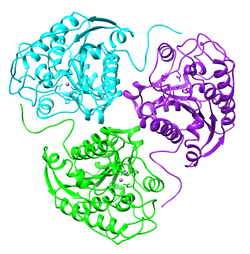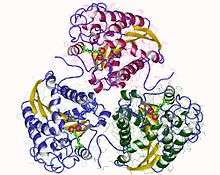Arginase
| Arginase | |||||||||
|---|---|---|---|---|---|---|---|---|---|
 | |||||||||
| Identifiers | |||||||||
| EC number | 3.5.3.1 | ||||||||
| CAS number | 9000-96-8 | ||||||||
| Databases | |||||||||
| IntEnz | IntEnz view | ||||||||
| BRENDA | BRENDA entry | ||||||||
| ExPASy | NiceZyme view | ||||||||
| KEGG | KEGG entry | ||||||||
| MetaCyc | metabolic pathway | ||||||||
| PRIAM | profile | ||||||||
| PDB structures | RCSB PDB PDBe PDBsum | ||||||||
| Gene Ontology | AmiGO / EGO | ||||||||
| |||||||||
| Liver arginase | |
|---|---|
 | |
| Identifiers | |
| Symbol | ARG1 |
| Entrez | 383 |
| HUGO | 663 |
| OMIM | 608313 |
| RefSeq | NM_000045 |
| UniProt | P05089 |
| Other data | |
| EC number | 3.5.3.1 |
| Locus | Chr. 6 q23 |
| Arginase, type II | |
|---|---|
| Identifiers | |
| Symbol | ARG2 |
| Entrez | 384 |
| HUGO | 664 |
| OMIM | 107830 |
| RefSeq | NM_001172 |
| UniProt | P78540 |
| Other data | |
| EC number | 3.5.3.1 |
| Locus | Chr. 14 q24.1 |
Arginase (EC 3.5.3.1, arginine amidinase, canavanase, L-arginase, arginine transamidinase) is a manganese-containing enzyme. The reaction catalyzed by this enzyme is: arginine + H2O → ornithine + urea. It is the final enzyme of the urea cycle. It is ubiquitous to all domains of life.
Structure and function
Arginase belong to the ureohydrolase family of enzymes.
Arginase catalyzes the fifth and final step in the urea cycle, a series of biochemical reactions in mammals during which the body disposes of harmful ammonia. Specifically, arginase converts L-arginine into L-ornithine and urea.[2] Mammalian arginase is active as a trimer, but some bacterial arginases are hexameric.[3] The enzyme requires a two-molecule metal cluster of manganese in order to maintain proper function. These Mn2+ ions coordinate with water, orienting and stabilizing the molecule and allowing water to act as a nucleophile and attack L-arginine, hydrolyzing it into ornithine and urea.[4]
In most mammals, two isozymes of this enzyme exist; the first, Arginase I, functions in the urea cycle, and is located primarily in the cytoplasm of the liver. The second isozyme, Arginase II, has been implicated in the regulation of the arginine/ornithine concentrations in the cell. It is located in mitochondria of several tissues in the body, with most abundance in the kidney and prostate. It may be found at lower levels in macrophages, lactating mammary glands, and brain.[5] The second isozyme may be found in the absence of other urea cycle enzymes.[4]
Mechanism
The active site holds L-arginine in place via hydrogen bonding between the guanidine chloride group with Glu227. This bonding orients L-arginine for nucleophilic attack by the metal-associated hydroxide ion at the guanidine chloride group. This results in a tetrahedral intermediate. The manganese ions act to stabilize both the hydroxyl group in the tetrahedral intermediate, as well as the developing sp3 lone electron pair on the NH2 group as the tetrahedral intermediate is formed.[6]
Arginase's active site is extraordinarily specific. Modifying the substrate structure and/or stereochemistry severely lowers the kinetic activity of the enzyme. This specificity occurs due to the high number of hydrogen bonds between substrate and enzyme; direct or water-facilitated hydrogen bonds exist, saturating both the four acceptor positions on the alpha carboxylate group and all three positions on the alpha amino group. N-hydroxy-L-arginine (NOHA), an intermediate of NO biosynthesis, is a moderate inhibitor of arginase. Crystal structure of its complex with the enzyme reveals that it displaces the metal-bridging hydroxide ion and bridges the binuclear manganese cluster.[6]
Additionally, 2(S)-amino-6-boronohexonic acid (ABH) is an L-arginine analogue that also creates a tetrahedral intermediate similar to that formed in the catalysis of the natural substrate, and is a potent inhibitor of human arginase I.[7]
Role in sexual response
Arginase II is coexpressed with nitric oxide (NO) synthase in smooth muscle tissue, such as the muscle in the genitals of both men and women. The contraction and relaxation of these muscles has been attributed to NO synthase, which causes rapid relaxation of smooth muscle tissue and facilitates engorgement of tissue necessary for normal sexual response. However, since NO synthase and arginase compete for the same substrate (L-arginine), over-expressed arginase can affect NO synthase activity and NO-dependent smooth muscle relaxation by depleting the substrate pool of L-arginine that would otherwise be available to NO synthase. In contrast, inhibiting arginase with ABH or other boronic acid inhibitors will maintain normal cellular levels of arginine, thus allowing for normal muscle relaxation and sexual response.[8]
Arginase is a controlling factor in both male erectile function and female sexual arousal, and is therefore a potential target for treatment of sexual dysfunction in both sexes. Additionally, supplementing the diet with additional L-arginine will decrease the amount of competition between arginase and NO synthase by providing extra substrate for each enzyme.[9]
Pathology
Arginase deficiency typically refers to decreased function of arginase I, the liver isoform of arginase. This deficiency is commonly referred to as hyperargininemia or arginemia. The disorder is hereditary and autosomal recessive. It is characterized by lowered activity of arginase in hepatic cells. It is considered to be the rarest of the heritable defects in ureagenesis. Arginase deficiency, unlike other urea cycle disorders, does not entirely prevent ureagenesis. A proposed reason for the continuation of arginase function is suggested by increased activity of arginase II in the kidneys of subjects with arginase I deficiency. Researchers believe that buildup of arginine triggers increased expression of arginase II. The enzymes in the kidney will then catalyze ureagenesis, compensating somewhat for a decrease in arginase I activity in the liver. Due to this alternate method of removing excess arginine and ammonia from the bloodstream, subjects with arginase deficiency tend to have longer lifespans than those who have other urea cycle defects.[10]
Symptoms of the disorder include neurological impairment, dementia, retardation of growth, and hyperammonemia. While some symptoms of the disease can be controlled via dietary restrictions and pharmaceutical developments, no cure or completely effective therapy currently exists.[10]
Animal studies
Arginase1 is activated by lactic acid in tumors to stimulate macrophages to help a tumor grow. When arginase1 was inhibited in a mouse model tumor size was greatly reduced.[11]
Arginase has been studied, in vitro, to treat several types of cancer, such as: breast, rectal, and colon. Arginase is used to decrease the arginine levels in blood serum in order to starving the cancer cells that are auxotrophic to arginine aminoacid. The in vivo approach revealed some problems that were overcame through some modifications that are described in several patent process, namely pegylation.[12]
References
- ↑ Di Costanzo L, Pique ME, Christianson DW (May 2007). "Crystal structure of human arginase I complexed with thiosemicarbazide reveals an unusual thiocarbonyl mu-sulfide ligand in the binuclear manganese cluster". J. Am. Chem. Soc. 129 (20): 6388–9. doi:10.1021/ja071567j. PMC 2593847
 . PMID 17469833.
. PMID 17469833. - ↑ Wu G, Morris SM (November 1998). "Arginine metabolism: nitric oxide and beyond". The Biochemical Journal. 336. ( Pt 1): 1–17. PMC 1219836
 . PMID 9806879.
. PMID 9806879. - ↑ Dowling DP, Di Costanzo L, Gennadios HA, Christianson DW (July 2008). "Evolution of the arginase fold and functional diversity". Cell. Mol. Life Sci. 65 (13): 2039–55. doi:10.1007/s00018-008-7554-z. PMC 2653620
 . PMID 18360740.
. PMID 18360740. - 1 2 Di Costanzo L, Moulin M, Haertlein M, Meilleur F, Christianson DW (September 2007). "Expression, purification, assay, and crystal structure of perdeuterated human arginase I". Archives of Biochemistry and Biophysics. 465 (1): 82–9. doi:10.1016/j.abb.2007.04.036. PMC 2018606
 . PMID 17562323.
. PMID 17562323. - ↑ Morris SM (2002). "Regulation of enzymes of the urea cycle and arginine metabolism". Annual Review of Nutrition. 22 (1): 87–105. doi:10.1146/annurev.nutr.22.110801.140547. PMID 12055339.
- 1 2 Reczkowski RS, Ash DE (July 1994). "Rat liver arginase: kinetic mechanism, alternate substrates, and inhibitors". Archives of Biochemistry and Biophysics. 312 (1): 31–7. doi:10.1006/abbi.1994.1276. PMID 8031143.
- ↑ Cox JD, Kim NN, Traish AM, Christianson DW (November 1999). "Arginase-boronic acid complex highlights a physiological role in erectile function". Nature Structural Biology. 6 (11): 1043–7. doi:10.1038/14929. PMID 10542097.
- ↑ Cama E, Colleluori DM, Emig FA, Shin H, Kim SW, Kim NN, Traish AM, Ash DE, Christianson DW (July 2003). "Human arginase II: crystal structure and physiological role in male and female sexual arousal". Biochemistry. 42 (28): 8445–51. doi:10.1021/bi034340j. PMID 12859189.
- ↑ Moody JA, Vernet D, Laidlaw S, Rajfer J, Gonzalez-Cadavid NF (September 1997). "Effects of long-term oral administration of L-arginine on the rat erectile response". The Journal of Urology. 158 (3 Pt 1): 942–7. doi:10.1016/S0022-5347(01)64368-4. PMID 9258123.
- 1 2 Iyer RK, Yoo PK, Kern RM, Rozengurt N, Tsoa R, O'Brien WE, Yu H, Grody WW, Cederbaum SD (July 2002). "Mouse model for human arginase deficiency". Molecular and Cellular Biology. 22 (13): 4491–8. doi:10.1128/MCB.22.13.4491-4498.2002. PMC 133904
 . PMID 12052859.
. PMID 12052859. - ↑ Colegio OR, Chu NQ, Szabo AL, Chu T, Rhebergen AM, Jairam V, Cyrus N, Brokowski CE, Eisenbarth SC, Phillips GM, Cline GW, Phillips AJ, Medzhitov R (2014). "Functional polarization of tumour-associated macrophages by tumour-derived lactic acid". Nature. 513 (7519): 559–63. doi:10.1038/nature13490. PMC 4301845
 . PMID 25043024.
. PMID 25043024. - ↑ Fernandes HS, Teixeira CS, Fernandes PA, Ramos MJ, Cerqueira NM (November 2016). "Amino acid deprivation using enzymes as a targeted therapy for cancer and viral infections". Expert Opinion on Therapeutic Patents. doi:10.1080/13543776.2017.1254194. PMID 27813440.
External links
- Arginase at the US National Library of Medicine Medical Subject Headings (MeSH)
- GeneReviews/NIH/NCBI/UW entry on Arginase Deficiency
- Arginase family signature and profile in PROSITE